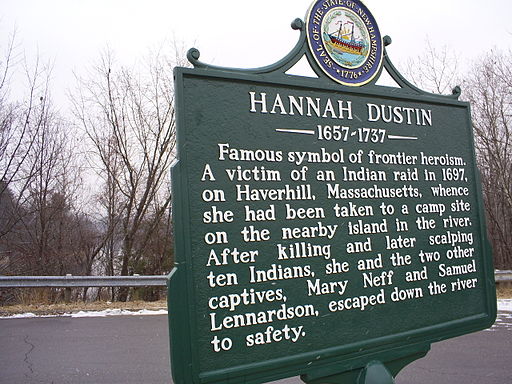7 Interesting Facts About Indian Captive and Escapee Hannah Dustin, an ancestor of my Great Grandmother, Alvra Cunningham (Mrs. Ralph Southworth)...and me
Hannah Emerson Dustin is one of my ancestors who had a moving and horrifying life experience. Hannah was born in 1657 and lived until about 1737. During the King William's War Hannah was abducted by Indians. People of that era were very hardy as they did endure hardships daily. She unquestionably was strong-willed and survived an intensely violent attack. Hannah, her nurse, and her newborn daughter were captured by Abenaki Indians in colonial Massachusetts. This is the story of her capture, her heroism, and some other interesting tidbits about her life.
1. Hannah, wearing her nightclothes, was abed holding her newborn infant when Indians came upon the homestead. Thomas, Hannah's husband ordered the older children to flee quickly to a garrison. Hannah sent Thomas after the children for their well-being, though it meant terror and impending death or capture to herself, her baby and a young nurse.
2. Thomas shot one Indian while rushing the children to hurry. They made it to the garrison alive but exhausted.
3. When the Abenaki Indians attacked, 40-year old Hannah (March 1697), her one-day old infant daughter, plus a young nurse Mary Neff were captured in Haverhill, Massachusetts. Almost 30 others from the frontier families were slain.
4. The captives were hastened to an Indian camp where the infant was slammed against a tree and died quite quickly from severe head injuries. Some tales speak of it being an apple tree. Mary's revenge ignited.
5. Hannah and her nurse were forced to march for several days in a northerly direction of about 75 or more miles. They were joined by another captive who was just 14 years of age, Samuel Lennardson, who had been a captive for about 18 months and was somewhat adapted to being an Indian captive versus risking escape. Samuel knew how the Abenaki killed and scalped captives. He shared this info with Hannah and Mary. Hannah during this travel was still in nightclothes; she may have had no shoes. The ground was somewhat covered with old snow, and the streams were touched with bits of ice. The women and Samuel likely suffered greatly from the cold.
 6. The Abenaki Confederation were allies with the French in Canada. Some Indians she encountered spoke French. It is likely that Hannah and the others were being marched to Canada where they would be sold into slavery.
6. The Abenaki Confederation were allies with the French in Canada. Some Indians she encountered spoke French. It is likely that Hannah and the others were being marched to Canada where they would be sold into slavery.
7. Hannah plotted their escape, and told Mary and Samuel to stay vigilant. The Indians did not have adequate guarding of the campsite. I have read that Hannah prepared soup for the captives and the Indians on the night they escaped. Some say that when serving, she may have tossed in an herb to help the Indians sleep or may even have added a local mushroom causing amatoxin poisoning. True or not, the Indians were evidently listless when shortly after midnight Hannah, Mary, and Samuel seized the Indian weapons and killed 10 Indians; 2 escaped.
8. The captives fled the scene, but Hannah returned shortly when she realized either that she might need proof of this adventure, or she remembered that Indian scalps provided precious monetary rewards. Hannah scalped the 10 dead; they did receive their rewards for killing the captors and having the scalps.
9. The group traveled south to home by canoe, traveling only during night's darkness. The trip took several days, but they did arrive home in Haverhill.
10. Hannah was the only female captive in New England history to massacre her captives and escape. Indian attacks had been endured for years; her escape was viewed as heroic.
11. Henry David Thoreau immortalized Hannah Dustin in his written works. In 1870 a statue of the courageous Hannah Dustin was positioned in the town square. There is also a statue of her in New Hampshire where Hannah and the captives killed the raiders and escaped with the scalps. Hannah's harrowing experience sparked the imagination of her fellow frontier colonists, just as it has endured and appealed to the people of today. Hannah Dustin Memorial statue was the first statue erected in NH using public funds. This occurred long after her death, in 1874.
12. John Greenleaf Whittier wrote of Hannah in his Legends of New England in 1831.
13. Cotton Mather penned Magnalia Christa Americana, in which Mather shared his respect for Hannah. He knew Hannah and spoke with her about the frightening incident himself. His version included moral questions which do not take away from the horror, but does speak of using the situation, perhaps, for his own means. Remember that Cotton Mather was a Puritan and a witch hunter in Salem.
14. Her husband Thomas participated in building more garrisons around Haverhill to ward off Indian attacks.
15. Hannah was a survivor and a heroine in her time. Since not much is known about her life after this harrowing event, she evidently proceeded to live a calmer existence until she died around 1737.
16. Sadly, Hannah had a sister, Elizabeth, who was severely beaten by their father as a child with a flail swingle and by her father's kicking of her body. Violence towards children was not uncommon, but her father Michael was brought to court and punished for his overzealous actions. Elizabeth did not marry, but had three bastard children. Years later, Hannah's sister killed her own illegitimate twin daughters immediately after birth. This was discovered and Elizabeth was hung.
17. Hannah and Elizabeth's surname is written many ways, such as Dustin and Duston. This is common in colonial history.
Thank you, ancestor Hannah Dustin, for being a survivor!
This was originally published by me on http://voices.yahoo.com/17-interesting-facts-indian-captive-escapee-12171756.htm
Sources:
